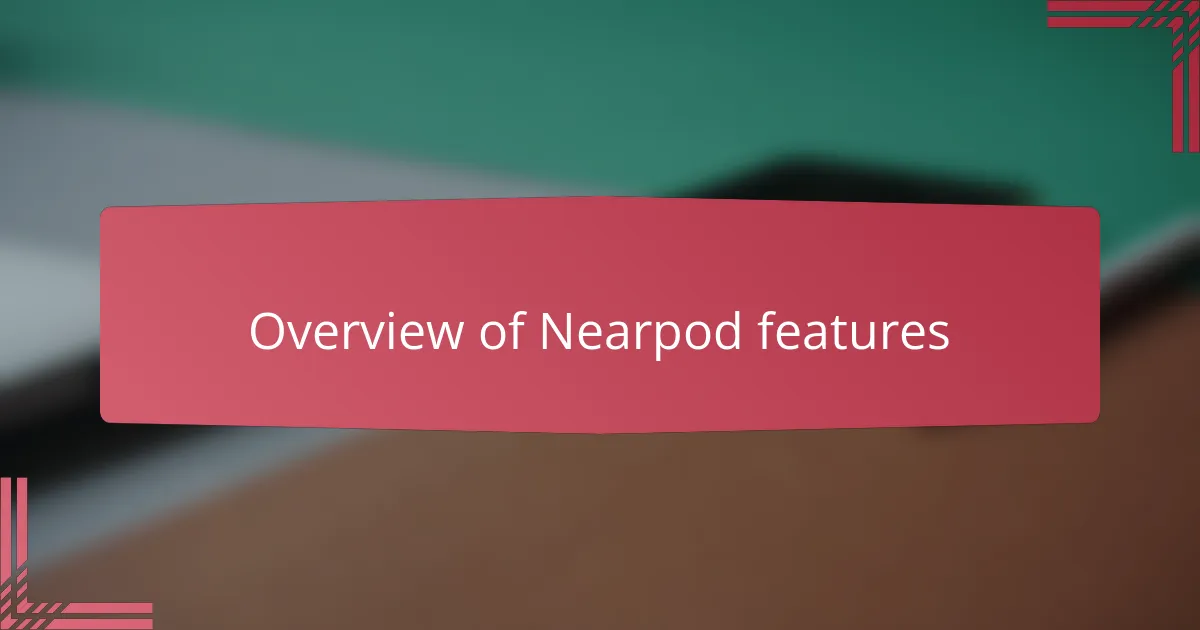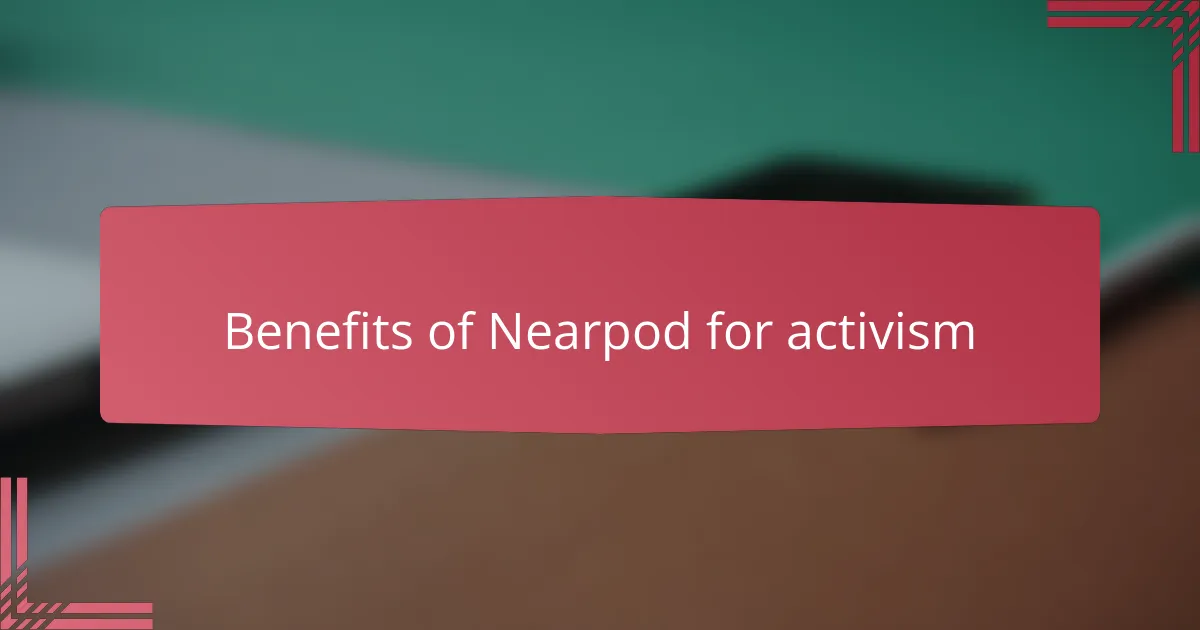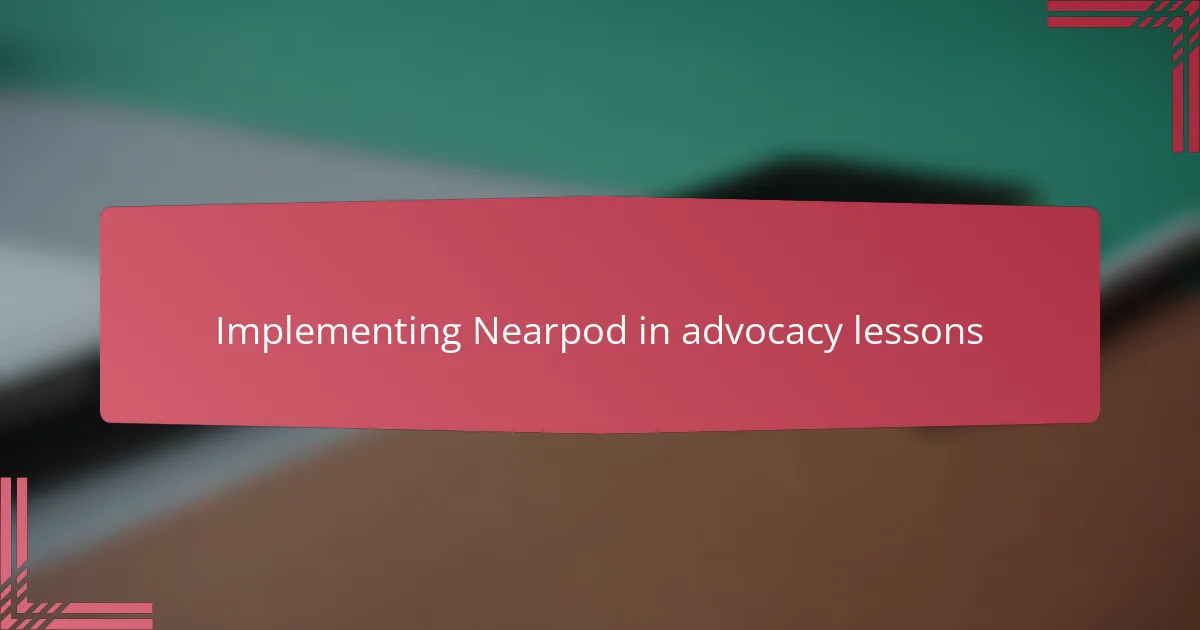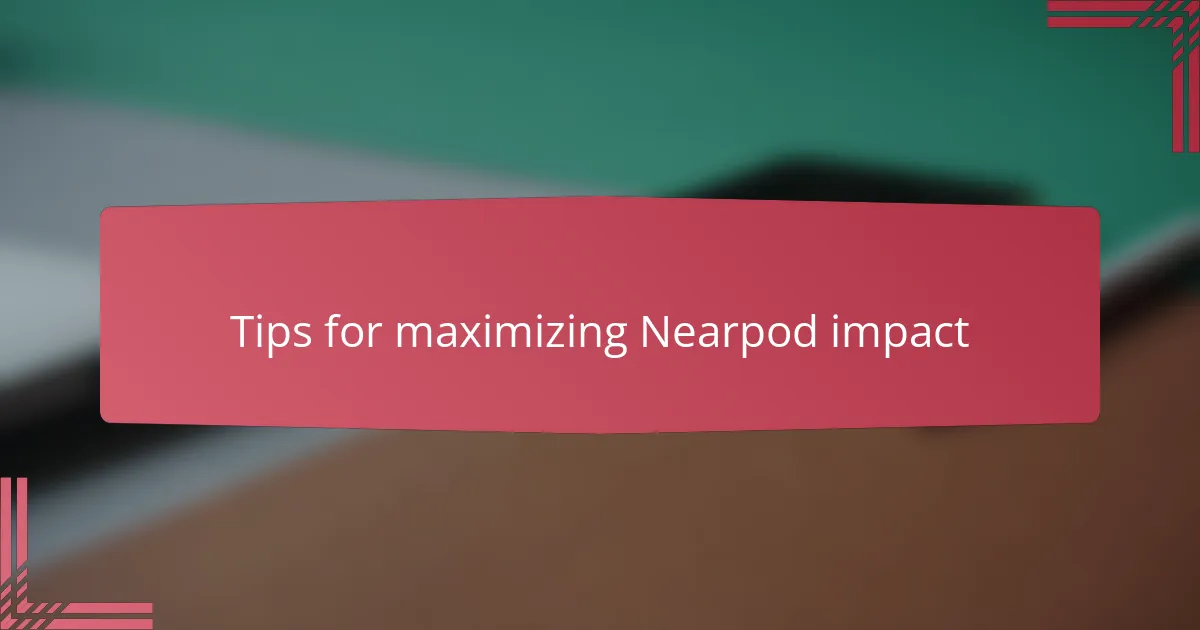Key takeaways
- Activist teacher resources empower educators to address social justice issues while fostering critical thinking and empathy among students.
- Nearpod enhances classroom engagement through interactive features, real-time feedback, and customizable lessons that adapt to student needs and perspectives.
- The platform facilitates safe discussions on complex topics, allowing students to voice their opinions and become active contributors to social change.
- Using multimedia and collaborative tools in Nearpod enriches learning experiences and encourages student agency in advocacy work.

Understanding activist teacher resources
Activist teacher resources are more than just tools; they are a lifeline for educators committed to social justice. When I first discovered these resources, I felt a renewed sense of purpose—it was like finding a community that truly understood the challenges I faced in the classroom. Have you ever wondered how powerful it feels to have materials that amplify your voice and values?
These resources help teachers not only convey information but also inspire critical thinking and empathy among students. From my experience, using activist resources transforms lessons from passive learning into active dialogue, making the classroom a space where students question the world around them. Isn’t that the kind of engagement we all strive for?
What stands out most to me is the way activist teacher resources encourage authenticity and courage. They give educators the confidence to tackle difficult topics head-on without feeling isolated or unsupported. Don’t we all need that kind of backing when pushing for meaningful change?

Overview of Nearpod features
Nearpod’s features immediately caught my attention because they offer interactive elements that go beyond traditional slides. I remember the first time I used its real-time quizzes and polls—it was like having a pulse on my students’ thoughts in the moment. Have you ever wished for a tool that lets you see where your class stands without interrupting the flow? Nearpod does exactly that.
What I find genuinely powerful is how Nearpod integrates multimedia, from videos to virtual field trips, all within one platform. This means I can create lessons that resonate emotionally and intellectually without juggling multiple apps. Isn’t it refreshing to have a seamless way to bring the world into your classroom?
Another feature that struck me is the ability to customize lessons on the fly. I’ve had moments when a student’s question shifted the whole discussion, and with Nearpod, I could adapt immediately. Don’t you think flexible teaching tools are essential in cultivating authentic, responsive learning experiences?

Benefits of Nearpod for activism
Nearpod opens up a unique space for activism in the classroom by making complex social issues accessible and engaging. When I used its collaborative boards during a lesson on community activism, I saw firsthand how students felt empowered to share their perspectives without fear of judgment. Have you noticed how creating a safe, interactive space can transform hesitant voices into passionate advocates?
One of the biggest benefits I’ve experienced is Nearpod’s ability to connect students with real-world experiences through virtual field trips and immersive content. It’s one thing to talk about activism theoretically, but it’s another to virtually stand alongside protesters or community leaders. Doesn’t that kind of firsthand exposure spark a deeper commitment to social change?
What truly impresses me is how Nearpod fosters critical thinking through instant feedback tools like polls and quizzes, allowing students to reflect on their own beliefs and biases in real time. I remember a moment when a poll revealed surprising opinions in my class, opening up an honest discussion about privilege and allyship. Isn’t that the kind of reflection that can lead to genuine transformation?

Personal experiences using Nearpod
Using Nearpod in my lessons has felt like discovering a new rhythm in teaching. I remember one session where a student hesitated to speak up until I launched a collaborative activity on Nearpod; suddenly, their voice came through loud and clear. Have you ever seen technology break down barriers like that in your own classroom?
There was also a time when I adjusted a Nearpod quiz in the moment because students brought up a current event that perfectly tied into our topic. That flexibility made the lesson feel alive and relevant—I could sense their engagement deepen immediately. Isn’t that responsiveness exactly what dynamic teaching is about?
What stays with me most is the confidence Nearpod gives me as an educator. Knowing I can create interactive spaces that honor diverse perspectives, even on challenging subjects, feels empowering. Don’t we all want tools that help us foster meaningful conversations without fear or hesitation?

Implementing Nearpod in advocacy lessons
Implementing Nearpod in advocacy lessons has truly changed the way I engage my students with social justice topics. I recall a lesson on environmental justice where Nearpod’s interactive features allowed students to share their own community concerns anonymously, sparking an honest and open dialogue. Have you ever found it challenging to create a safe space for sensitive discussions? Nearpod helped me overcome that hurdle effortlessly.
What strikes me most is how Nearpod encourages student agency in advocacy work. During an online unit about voting rights, students used collaborative boards to draft their own campaign ideas, transforming from passive learners into active changemakers. Isn’t it incredible when a tool not only informs but empowers students to take real-world action?
On a practical level, Nearpod’s real-time feedback tools have made it easier to guide discussions on complex issues like systemic racism. I remember noticing through a quick poll that many students held misconceptions that we unpacked together immediately. Could there be a better way to ensure everyone is heard and understood while keeping lessons fluid and responsive?

Tips for maximizing Nearpod impact
One tip I’ve found invaluable is to plan your Nearpod lessons with built-in moments for reflection and discussion. When I intentionally pause for a collaborative board or poll, it feels like the classroom breathes collectively, giving students space to process and respond authentically. Have you noticed how these pauses can transform a lesson from lecture to lively exchange?
Another strategy that works well is customizing Nearpod activities based on real-time student responses. I remember a time when a poll revealed unexpected opinions, and I quickly adapted the lesson to explore those viewpoints deeper. Doesn’t that real-time flexibility make your teaching feel more responsive and connected to your students’ needs?
Lastly, don’t underestimate the power of embedding multimedia that speaks directly to social justice themes. Mixing videos, images, and virtual field trips keeps the energy high and appeals to different learning styles. I’ve seen firsthand how this variety sparks curiosity and fuels passionate conversations—how could we not want to keep students engaged this way?

Reflecting on Nearpod’s educational value
Thinking back on Nearpod’s educational value, I’m struck by how it transforms static lessons into dynamic experiences. One time, during a history unit, I watched students who usually stayed quiet suddenly light up when interacting with a Nearpod activity. Have you experienced that moment when a tool makes learning feel alive? That’s the kind of impact I value most.
What really makes Nearpod stand out for me is its seamless blend of interactivity and accessibility. It’s not just about flashy tech; it’s a platform that respects diverse learning styles while promoting engagement. I recall how a simple poll once uncovered differing student perspectives I hadn’t anticipated, opening the door for a rich, meaningful conversation. Doesn’t that kind of insight make teaching deeply rewarding?
At the heart of it, Nearpod’s value lies in its ability to create thoughtful, inclusive classrooms where every voice matters. I’ve felt firsthand how the platform gives me the confidence to guide sensitive discussions with empathy and clarity. Isn’t that what we all want—to build learning environments that nurture understanding and growth?